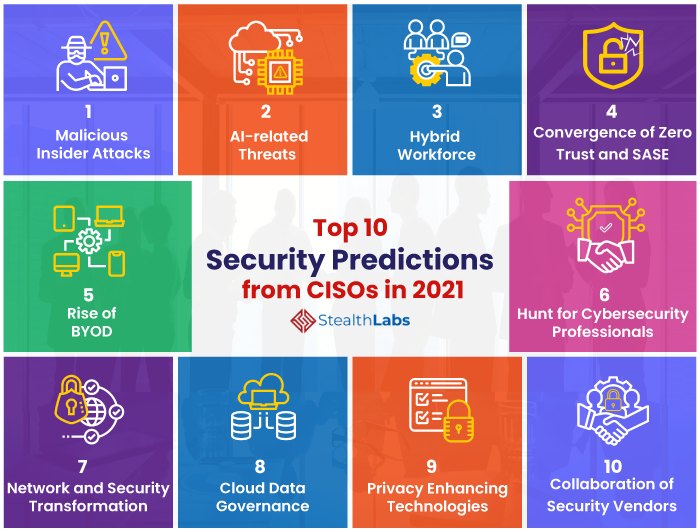Top 10 Chief Information Security Officer (CISO) Predictions In 2021
The coronavirus pandemic has forced global businesses to adopt new ways of working and collaborating. As a consequence, the demand for digital technology has skyrocketed. Such rise of technology need has also become a much bigger and more lucrative target for cybercriminals.
The year 2020 became the ‘worst year on record’ in terms of number of records exposed due to cyberattacks and data breaches. The Chief Information Security Officers (CISOs) responded quickly to the pandemic by instituting secure connections for the newly minted remote workforce. However, there are quite a number of devastating data breach incidents that made headlines in 2020.
To succeed in the post-pandemic era, the CISOs must rethink their security strategies and stay abreast with the latest cybersecurity trends to navigate a new threat landscape.
Here are some of the top security predictions and trends from CISOs in 2021:
Top Security Predictions from CISOs in 2021 and Beyond

1) Malicious Insider Attacks
According to Forrester, insider threats are predicted to rise by 8% in 2021, accounting for 33% of all cyberattacks. The remote-working trend is considered to be the prime driver for the steep rise in insider threats. As the crisis drags on, uncertainty, changing circumstances, and employee fears around job loss, paired with the ease the data can be moved, could translate to an increase in insider threats.
Also Read: What Are Insider Threats and How Can You Mitigate Them?
2) AI-related Threats
Though the advancements in Artificial Intelligence (AI) can induce tremendous growth in automation and innovation, they can be used maliciously. AI-based cyberattacks such as the poisoning of training data sets, model corruption, and high-level social networking mapping will grow in the future.
3) Hybrid Workforce
Almost all companies have adopted a fully remote working culture amid the pandemic. In the current year, many of these companies will need to embrace a hybrid workforce, with some employees working in the office and others remotely.
Also Read: Employees Working From Home: Top 14 Checklist Points For Your Cybersecurity!
4) Convergence of Zero Trust and SASE
Amid the uncertainty, Zero-Trust Network Access (ZTNA) has become pivotal in providing controlled access to resources and reducing the surface area network. However, a Secure Access Service Edge (SASE) technology will be essential to enable a holistic zero-trust implementation. This convergence will become a cornerstone for any future business transformation, offering full visibility, control, and enablement for a secure cloud transformation.
5) Rise of BYOD
As we continue to practice social distancing in 2021, organizations will shift from shared or communal computers to BYOD, laptops, and other personal devices. In response, security teams will also need to embrace authentication practices that support both office and remote employees. Multi-Factor Authentication (MFA) will be the most popular security practice for BYOD devices.
6) Hunt for Cybersecurity Professionals
As with every year, the hiring of cybersecurity professionals will continue in 2021. According to The New York Times, the demand for cybersecurity jobs will increase manifold, resulting in 3.5 million vacancies by 2021. Companies will hire cybersecurity professionals in the office and remotely.
7) Network and Security Transformation
As organizations transit from appliance-based security technologies to cloud-based security models such as SASE, the IT and security teams will realize operational efficiencies and cost savings. The move to the cloud will help organizations save costs between 20-40% in 2021. Moreover, with cloud migration, the traditional network and security stack becomes less reliant, and the network and security teams will align closely.
8) Cloud Data Governance
Cloud promises to improve business agility and accelerate innovation by enabling organizations to leverage data in new ways. However, organizations must stay compliant with emerging data privacy and security regulations to efficiently share, access, and leverage data in the cloud.
This year, organizations will increasingly adopt new cloud data governance solutions and strategies that enable effective utilization of data while automating compliance with data privacy regulations.
Also Read: Cybersecurity Services Company in USA
9) Privacy Enhancing Technologies
The pandemic has been a catalyst to accelerate and strengthen digital transformation across the world. However, it has also led to the proliferation of cyberattacks and data breaches. As a result, there will be a broader adoption of Privacy Enhancing Technologies (PET’s) to enhance personal data protection and enable business value, thus meeting various privacy requirements.
Also Read: Cybersecurity for SMBs: Importance, Challenges and Tips
10) Collaboration of Security Vendors
The coronavirus pandemic has provided a lucrative opportunity for cybercriminals to exploit people and organizations. They became stronger amid the pandemic and increasingly collaborated among themselves to come up with new threats by the minute.
In the wake of the growing complexity of the threat landscape, the collaboration between security vendors and intelligence sharing will be important than ever in 2021. We will increasingly see security vendors working together to share threat insights through Information Sharing Analysis Centers (ISACs).
In Conclusion
In the present era of cyber everywhere, with more digital transformation, cloud migration, and broader networking capabilities, the cyberthreat landscape continues to evolve. Cybercriminals will continue to adopt highly sophisticated ways to carry out enterprise-wide destructive cyberattacks.
Thus, organizations must partner with Managed Security Service Providers like StealthLabs to prepare, respond, recover, and transform strategically from evolving cyber threats.

